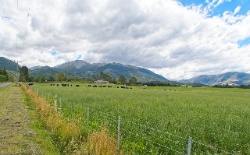National Climate Summary – September 2005
NATIONAL CLIMATE CENTRE
TUESDAY 11 OCTOBER 2005
National Climate Summary – September 2005
- Rainfall: Below average in many regions, especially Nelson
- Temperature: Above average almost everywhere
- Sunshine: Sunny over much of the North Island, below average sunshine in coastal Canterbury
- Snowstorm: Significant snowfall event affects the eastern South Island
September was the third consecutive month with above average temperatures. September was also drier and sunnier than normal in many regions, especially during the first two weeks and in the closing days. However, a significant very cold outbreak with snow to low levels followed by severe frost affected some areas during the third week. Rainfall was well below average in parts of Nelson. Appleby’s rainfall totalled 9 mm (11 percent of normal), was the lowest September total in more than 70 years of measurement. Rainfall was less than 50 percent (half) of normal in Gisborne and Marlborough. A lack of substantial rainfall in North and Central Otago and South Canterbury (less than 25 mm for the month in some areas) resulted in a continuation of significant soil moisture deficits. Fire bans existed in parts of Canterbury and Otago at the start of the month. September was the third consecutive month with above average temperatures. The month was warmer than average almost everywhere, the national average temperature of 11.1 °C being 0.7 °C above normal. September was sunnier than average in many North Island regions south of Waikato and Bay of Plenty, inland south Canterbury and Southland. There were more anticyclones than average east of the North Island, and also south of the South Island. This pattern produced more frequent northerlies over the North Island.
Other Highlights:
- The highest temperature during September 2005 was 23.6 °C recorded at Hanmer Forest on the 11th, and in Henderson, Auckland on the 12th. The lowest temperature for the month was -7.0°C, at Arthurs Pass, on the 20th.
- The highest wind gust for the month was 156 km/h from the southwest, recorded at Cape Reinga on the 19th.
- High rainfall totalling 338 mm was recorded at Arthur’s Pass between 4 and 7 September.
- A tornado struck Hokitika on the 5th, lifting a house roof, smashing windows, overturning a furniture truck, and leaving a trail of damage.
- A deep depression was accompanied by high rainfall and gale force winds in parts of Northland, Bay of Plenty and Taranaki on the 18th, with a damaging tornado in Hamilton. An unseasonably cold southerly outbreak followed, with snowfall to sea level in Canterbury on the 19th. The southerlies produced hail showers in the lower North Island, and resulted in significant fresh snowfall in the central North Island mountains, and closed the Desert Road. Severe ground frosts followed in some areas over 20-21 September. Frost prevention measures occurred in many areas, including the use of helicopters, to avoid potential plant damage.
- Of the four main centres Christchurch was the driest and Wellington was the sunniest. Auckland was warmer than average. Wellington was warmer, sunnier, and much drier than average. Christchurch was rather cloudy and drier than average. Dunedin was sunnier with near average rainfall and temperature.
Rainfall: Rainfall was less than 25 percent of normal rainfall in parts of Nelson, and less than 50 percent of normal in Gisborne and Marlborough. Totals were average or below average in most other regions. Scattered areas of above average rainfall (at least 125 percent of normal) occurred in isolated parts of Northland, Waikato, Wanganui, Manawatu, and Westland.
Temperature: Mean temperatures were above average almost everywhere, and almost 1.5 °C above average in parts of Otago, and 1.0 °C above average in the northern half of the North Island from Northland to Bay of Plenty, as well as Wellington, and much of the South Island.
Sunshine: Sunshine hours were at least 120 percent of average in Manawatu and Gisborne, and more than 110 percent of average in many North Island regions south of Waikato and Bay of Plenty, inland south Canterbury and Southland. In contrast, it was rather cloudy in coastal areas of Canterbury.
ENDS
BELOW AVERAGE RAINFALL IN MANY REGIONS, ESPECIALLY NELSON
Rainfall was less than 25 percent of normal rainfall in parts of Nelson, less than 50 percent of normal in Gisborne, Marlborough, and less than 75 percent (three quarters) of normal in much of Coromandel, Bay of Plenty, Hawke’s Bay, Wairarapa, Kapiti, Wellington, Buller, south Canterbury, and Central Otago. Scattered areas of above average rainfall (at least 125 percent of normal) occurred in isolated parts of Northland, Waikato, Wanganui, Manawatu, and Westland. Rainfall was near normal elsewhere.
Near or record low September rainfall was recorded at:
Location September Rainfall
(mm) PercentageOf normal Year records
began Comments
Takaka 51 25 1986 Lowest
Motueka 23 20 1943 Lowest
Appleby 9 11 1932 Lowest
Blenheim Research 19 30 1985 2nd lowest
ABOVE
AVERAGE TEMPERATURES
Mean temperatures were almost 1.5 °C above average in parts of Otago, 1.0 °C above average in the northern half of the North Island from Northland to Bay of Plenty, as well as Wellington, and much of the South Island. Temperatures were 0.5 °C above average in other North Island regions, as well as Buller, Canterbury, and coastal Otago. The national average temperature was 11.1°C, 0.7°C above average.
Near or record high September mean air temperatures were recorded at:
Location Mean
temperature Departure from average
(°C) RecordsBegan Comments
Whakatane
Airport 12.5 +1.3 1975 2nd highest 122 128
129
Motu 9.7 +1.6 1991 2nd highest
Wellington,
Kelburn 11.9 +1.3 1928 3rd
highest
Stratford 10.7 +1.3 1960 3rd equal highest
Wanganui, Spriggens Park 13.0 +1.3 1937 3rd highest
Farewell Spit 12.8 +1.5 1971 Equal highest
Motueka,
Riwaka 11.3 +1.2 1956 2nd highest
Wanaka
Airport 9.8 +1.4 1992 Highest
Invercargill
Airport 9.6 +1.2 1948 3rd equal highest
VERY SUNNY IN
MANAWATU AND GISBORNE, BELOW AVERAGE TOTALS IN COASTAL
CANTERBURY
Sunshine hours were at least 120 percent of average in Manawatu and Gisborne, and more than 110 percent of average in other western North Island regions from Taranaki to Wellington, the east of the North Island from Hawke’s Bay to Wairarapa, and inland south Canterbury, coastal Otago and Southland. It was cloudier than normal in the Southern Lakes, and coastal areas of Canterbury.
Near or record September sunshine hours were recorded at:
Location September sunshine (hours) Percentage of
normal Year Records began Comments
Gisborne
Airport 218 126 1905 Well above average
Palmerston
North 194 162 1930 3rd highest
Christchurch
Airport 108 65 1949 2nd lowest
SEPTEMBER’S CLIMATE IN
THE FOUR MAIN CENTRES
Of the four main centres Christchurch was the driest, while Wellington was the sunniest. Rainfall was below average in Christchurch and Wellington, and near average in Auckland and Dunedin. Temperatures were above average in Auckland and Wellington, and near average in Christchurch and Dunedin. Sunshine hours were above average in Wellington, below average in Christchurch, and near average in Auckland and Dunedin.
Location Sept. Mean Temp. (°C) Dep. From
normal (°C) Sept. rainfall(mm) % of normal Sept. Sunshine
(hours) % of Normal
Auckland 13.7a +0.8 Above
average 98b 84 Near
average 150a 100 Average
Wellington 11.9 +1.3 Well above
average 50 50 Well below average 185 119 Above
average
Christchurch 9.3c 0.0 Average 36c
78 Below average 108 65 Well below Average
Dunedin 9.5
+0.3 Near average 48 89 Near average 144 112 Above
average
a Mangere b Mt Albert c
Christchurch Airport
HIGHLIGHTS AND EXTREME
EVENTS
- Temperature
The highest temperature during
September 2005 was 23.6 °C recorded at Hanmer Forest on the
11th, and in Henderson, Auckland on the 12th. The lowest
temperature for the month was -7.0°C at Arthurs Pass on the
20th.
Near or record September air temperatures were recorded at:
Location Maximum temperature °C Date of
occurrence Year
Records began Comments
Auckland,
Henderson 23.3 12th 1986 Highest
- Rainfall
High
rainfall totalling 338 mm was recorded at Arthurs Pass
between 4 and 7 September.
- High winds
The highest
wind gust for the month was 156 km/h from the southwest,
recorded at Cape Reinga on the 19th.
A tornado struck
Hokitika at 12.30am on the 5th, lifting a house roof,
smashing windows, overturning a furniture truck, and leaving
a trail of damage.
- Fog
Flights were cancelled for
several hours due to fog in Auckland on the 2nd.
-
Significant snowfall and severe frosts
A depression which
had intensified over the Tasman Sea tracked over the lower
North Island (with central pressures below 970 hPa) on the
18th. This was accompanied by rainfall totalling 50-80 in
parts of Northland, Bay of Plenty and Taranaki, along with
gale force winds. In Hamilton a tornado damaged several
roofs and felled trees. An unseasonably cold southerly
outbreak followed, with snowfall to sea level in Canterbury
on the 19th. The snowfall resulted in the closure of
Christchurch Airport, along with schools and universities,
with snow depths of 5-10 cm reported in the region. Power
cuts also occurred. The maximum air temperature at the
airport was only 4.8 °C on 19 September, the lowest there in
September in records that commenced in 1954. The
southerlies produced hail showers in the lower North Island,
and resulted in significant fresh snowfall in the central
North Island mountains, and closed the Desert Road. In
Canterbury, hundreds of newborn lambs died in the cold.
Snowfall depths of 10 cm were reported in the Queenstown
district. With 25 cm of new snow, Coronet Peak ski field was
able to reopen after having closed early on 12 September.
Further south, snow lay briefly in Alexandra on the 19th.
The cold southerlies were followed by severe ground frosts
(grass minimum temperature -6.0 °C or lower) in the central
North Island, Hawke’s Bay, Manawatu, Kapiti, Wellington,
Nelson, inland areas of Buller and Marlborough, Canterbury,
Otago and Southland over 20-21 September. Further severe
ground frost was measured in Otago on 24 September. Frost
prevention measures, including the use of helicopters, were
taken to avoid potential plant damage, especially in
Marlborough and Hawke’s Bay.
www.niwa.co.nz/ncc Copyright NIWA 2005. All rights reserved.


 Fix & Fogg: NASA Hand-picks Kiwi Nut Butter Brand To Travel To Space In NZ First
Fix & Fogg: NASA Hand-picks Kiwi Nut Butter Brand To Travel To Space In NZ First Citizens of the Sea: Sailors To Revolutionise Our Understanding Of Pacific Biodiversity
Citizens of the Sea: Sailors To Revolutionise Our Understanding Of Pacific Biodiversity Netsafe: Making A Splash With Online Safety: Netsafe Launches New Flagship Programme For Kids
Netsafe: Making A Splash With Online Safety: Netsafe Launches New Flagship Programme For Kids NZGBC: Flood Resilience PhD Student Widi Auliagisni Named Future Thinker Of The Year 2024
NZGBC: Flood Resilience PhD Student Widi Auliagisni Named Future Thinker Of The Year 2024 Business Canterbury: European Free Trade Agreement A Game-changer For Canterbury
Business Canterbury: European Free Trade Agreement A Game-changer For Canterbury Business Canterbury: Urges Council To Cut Costs, Not Ambition For City
Business Canterbury: Urges Council To Cut Costs, Not Ambition For City



